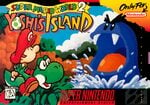Template:Featured: Difference between revisions
m (Corrected the link of an article.) |
No edit summary Tags: Mobile edit Advanced mobile edit |
||
| (86 intermediate revisions by 12 users not shown) | |||
| Line 1: | Line 1: | ||
<noinclude>'''Please read:''' If you are going to replace the current information on the Featured template, please see [[Template:UpcomingFA|here]] before doing that and look at which order our next FAs will be put on this page. [[Category:Main page templates]]</noinclude>{{featured-image| | <noinclude>'''Please read:''' If you are going to replace the current information on the Featured template, please see [[Template:UpcomingFA|here]] before doing that and look at which order our next FAs will be put on this page. [[Category:Main page templates]]</noinclude>{{featured-image|SMW2.jpg|150px}} | ||
'''''[[Super Mario World 2: Yoshi's Island]]''''' (frequently referred to simply as '''''Yoshi's Island''''') is a 2D [[Genre#Platform games|platform game]] for the [[Super Nintendo Entertainment System]], developed by [[Nintendo Entertainment Analysis and Development|Nintendo EAD]]. The game is the prequel to ''[[Super Mario World]]'', and it stars [[Yoshi]] and the [[Yoshi (species)|Yoshi clan]] who, while carrying [[baby Mario]], travel across [[Yoshi's Island (location)|Yoshi's Island]] to rescue [[baby Luigi]] from [[baby Bowser]] and his [[Magikoopa]] minion/caretaker, [[Kamek]]. Instead of relying on [[jump]]ing and a power-up system for combat as in the traditional ''Super Mario'' platformers, Yoshis use their tongue and eggs to overcome obstacles, as well as the introduction of many other different mechanics. The game is notable for introducing a time-based health system rather than hit points, an anomaly to what many platform games typically did in this game's time period. Rather than relying on powerful pre-rendered graphics just like its contemporary ''[[Donkey Kong Country]]'', ''Super Mario World 2: Yoshi's Island'' employs a very distinct, stylized arts and crafts style to stand on its own. The game makes use of the Super FX2 graphics chip (one of only four commercially released SNES games to do so), which allows for larger, more detailed sprites and more advanced effects that emulate 3D space. | |||
Latest revision as of 00:43, November 16, 2024
Please read: If you are going to replace the current information on the Featured template, please see here before doing that and look at which order our next FAs will be put on this page.
Super Mario World 2: Yoshi's Island (frequently referred to simply as Yoshi's Island) is a 2D platform game for the Super Nintendo Entertainment System, developed by Nintendo EAD. The game is the prequel to Super Mario World, and it stars Yoshi and the Yoshi clan who, while carrying baby Mario, travel across Yoshi's Island to rescue baby Luigi from baby Bowser and his Magikoopa minion/caretaker, Kamek. Instead of relying on jumping and a power-up system for combat as in the traditional Super Mario platformers, Yoshis use their tongue and eggs to overcome obstacles, as well as the introduction of many other different mechanics. The game is notable for introducing a time-based health system rather than hit points, an anomaly to what many platform games typically did in this game's time period. Rather than relying on powerful pre-rendered graphics just like its contemporary Donkey Kong Country, Super Mario World 2: Yoshi's Island employs a very distinct, stylized arts and crafts style to stand on its own. The game makes use of the Super FX2 graphics chip (one of only four commercially released SNES games to do so), which allows for larger, more detailed sprites and more advanced effects that emulate 3D space.
